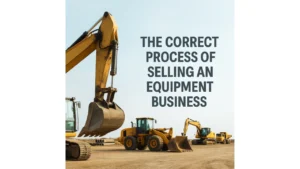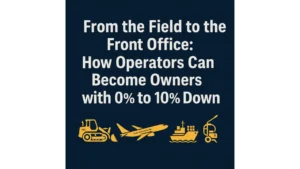When acquiring a heavy equipment rental business, one of the most critical but often overlooked elements of the transaction is understanding how the capital stack is structured. The capital stack defines who gets paid, in what order, and with what level of risk. It’s the financial blueprint of the deal.
What Is the Capital Stack?
The capital stack refers to the layers of capital used to fund a business or acquisition. Each layer carries different levels of risk, return, and control. Think of it like a financial pyramid: the lower the layer, the more secure it is, while the top layers carry more risk but also more upside.
Typical layers include:
- Senior Debt – Bank or SBA loans. Lowest cost, lowest risk for the lender. Comes with strict repayment schedules and covenants.
- Subordinated Debt / Seller Carry – A secondary loan that’s junior to senior debt. Higher risk, but helpful in bridging the deal without requiring more equity.
- Equity – The riskiest layer. Equity holders get paid last, but they own the upside and have control.
Capital Stack Example: $5 Million Equipment Rental Acquisition
Let’s break down a typical capital structure using a 90/5/5 model:
- $4.5M Senior Debt (90%) • SBA 7(a) or 504 loan • Collateralized by cash flow and equipment • Low interest, long-term amortization
- $250K Seller Financing (5%) • Deferred payments, often interest-only at first • Subordinated to senior debt • Shows seller confidence and alignment
- $250K Equity Injection (5%) • Your capital or outside investors • Carries the most risk, but all control and upside sit here
Why the Capital Stack Matters
- Risk Allocation: Each layer of capital absorbs different risk. You protect yourself and investors by designing the stack to minimize exposure and preserve control.
- Return Optimization: Senior lenders want predictable payments. Equity holders want high returns. Balancing both increases the chance of closing and scaling successfully.
- Control: The more you fund with debt and seller financing, the less equity you need to give up. That means more control and future wealth stays with you.
Watch Out For
- Over-Leveraging: 90% debt only works if the company has stable, predictable cash flow. Equipment rental is cyclical be cautious.
- Underfunding Working Capital: Don’t structure the stack so tight that you can’t afford parts, repairs, or hiring post-close.
- Ignoring Fleet CapEx: You’ll need to continuously reinvest in your equipment to stay competitive. Your capital structure should leave margin for this.
Final Thought
In acquisitions, the capital stack isn’t just numbers on a spreadsheet—it’s the architecture that determines your risk, return, and control. A well-structured stack gives you leverage without sacrificing long-term gains. When buying a heavy equipment rental company, build it right from day one.
Gustavo Lopez Partner | Strategic Structuring & Capital Operations Focused on aviation, heavy equipment, and asset-backed growth models.
#BuyRepairRent #RentalOperations #EquipmentRentalBusiness #UtilizationStrategy #FleetOptimization #HeavyEquipmentOperators






